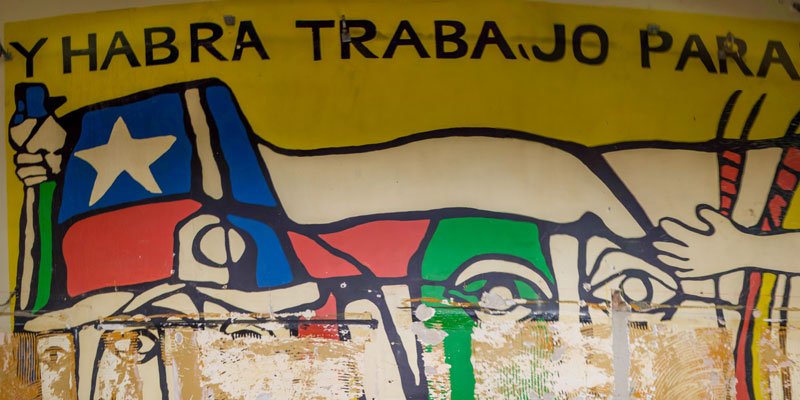Painted by refugees in the 1970s, this Chilean mural was long forgotten before being discovered by chance. The Gryphon attended its relaunching event, to discover its symbolic importance in the struggle against injustice.
On 7th December, the LUU held a launch event for the restoration of a mural that had been hidden for 40 years behind a wall in the Union foyer. It was spotted by Chilean Ph.D. student, Mario Alvarez Fuentes, who noticed his country’s flag on the wall during a refurbishment in the Union. He contacted the wider Chilean community about the mural who subsequently, in an open letter to the LUU, expressed the cultural significance of the mural and the necessity of its restoration.
It was painted in 1976 by a group of Chilean students who came to Leeds as political refugees fleeing Pinochet’s military dictatorship. Chileans created the mural in the union to draw attention to the dictatorship, the plight of the Chilean people, and act as a symbol of workers solidarity, a crucial part of Chilean heritage. It depicts miners and agricultural workers with ‘And There Will be Work for All’ written in Spanish, a popular socialist slogan.
General Pinochet’s regime was an authoritarian military government that ruled Chile between 1973 and 1990, established after the democratically-elected socialist government of Salvador Allende was overthrown by a CIA-backed coup d’état on 11 September 1973. The regime was characterised by the systematic suppression and persecution of dissenters. The regime left thousands dead or missing and tortured many more, driving an estimated 200,000 Chileans into exile.
Political activists, artists, musicians, intellectuals and Chilean citizens, fled their homes with many settling in neighbouring Latin American countries. However, in an agreement with the UN High Commission for Refugees, the UK arranged to accept 3,000 Chilean refugees.
“Chileans created the mural in the Students’ Union to draw attention to the dictatorship, the plight of the Chilean people, and act as a symbol of workers solidarity”
The launch event featured an exhibition which encouraged the audience to engage with the mural by listening to interviews with individuals from the Chilean community and read articles, pictures, and newspaper cuttings from the era. The event also hosted talks by members of the Chilean community including Gilberto Hernandez, one of the Chileans who painted the mural, and people involved in the restoration project such as Sarah Rainey, an MA student in Art Gallery and Museum Studies. Miss Rainey expressed the importance of enabling the Chilean people to tell their stories in their own words and not have their stories told for them.
The mural restoration, supported by the Heritage Lottery Fund, has been hailed as a project of great symbolic significance and an important demonstration of the Union’s commitment, historically and presently, to supporting student political activism, expression and art and strengthening bonds with communities of various kinds.
LUU states that the mural will “form the centrepiece of a resource library dedicated to refugees and asylum seekers, bringing members of the student, local and Chilean communities together. A programme of educational workshops on muralism, a collection of oral histories by Chilean volunteers, and a walking tour of mural sites in Leeds will enable everyone to discover the rich history behind this culturally important artwork.”
Speaking at the event, Gilberto Hernandez spoke about the warm welcome he received when he arrived in Leeds and how various organisations – trade unions, grassroots movements – came together to provide support to the Chileans in their time of need. He talked about how the university was a place where many Chilean students came together for meetings and discussions and that some were even enabled to continue their studies at the University of Leeds. He stressed the importance of the mural and “the role that visual communication plays in changing injustices that occur daily in the world.”
LUU Education Officer, Zaki Kaf Al-Ghazal, said that he wanted the Union to be a ‘microcosm’ for the community, country, and the world in its commitment to openness and acceptance for refugees through the Sanctuary Scholarship, particularly at a time when there is an increase in far-right attacks. Though the mural reflects the injustice that emanated in 1970s Chile, it is a symbol of the necessity to resist, fight and conquer modern injustices that permeate through our society.
Inaya Folarin
[Image: LUU] Image is before restoration

